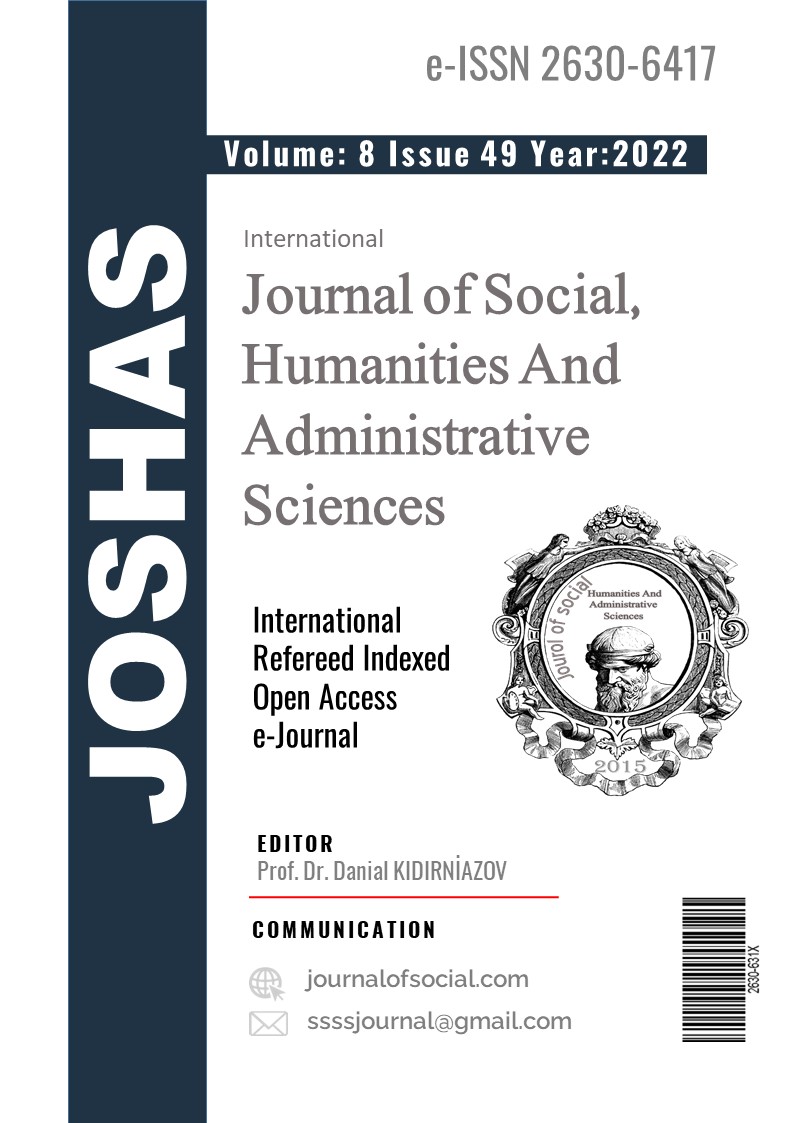Türkiye Cumhuriyeti’nin Kamu Eliyle Kurulan İlk Halkla İlişkiler Ajansı Milli İktisat Ve Tasarruf Cemiyeti
Author :
Abstract
Türkiye halkla ilişkiler tarihi incelendiğinde halkla ilişkilerin uygulamada ve literatüre girmesinde kamunun belirleyici olduğu bilinmektedir. Türkiye’nin özel girişimlerle kurulan ilk halkla ilişkiler ajansı, A&B adıyla, 1974 yılında Alaeddin Asna tarafından kurulsa da bu makalede ilk halkla ilişkiler ajansının halkla ilişkiler adı altında olmasa da kamu eliyle kurulan Milli İktisat ve Tasarruf Cemiyeti olduğu öne sürülmektedir. Bu bağlamda da makalede Cemiyetin yaptığı uygulamalar, bu uygulamalarda kullandığı strateji, yöntem, taktikler ve kullandığı araçlar irdelenmiştir. Milli İktisat ve Tasarruf Cemiyeti faaliyetleri üç temel strateji yerli malı, tasarruf ve yurt sevgisi temelinde planlanmıştır. Cemiyet, halkla ilişkiler uygulama alanlarından konu ve gündem yönetimi, kriz iletişimi, medyayla ilişkiler, etkinlik yönetimi ve itibar yönetimi gibi uygulamaları planlamış ve uygulamıştır. Cemiyetin kullandığı araç ve yöntemler ise gazete, dergi, kitap, Hesabını Bilenin Defteri ,radyo, açıkhava(Sokak afişleri), bülten, katalog, afiş, ilan, broşür, kanaat önderleri gibi araçları, yarışma, toplantı, sergi ve tören gibi yöntemleri kullanmıştır. Cemiyetin iletişim faaliyetlerini yönelttiği hedef kitle ise kadın, çocuk, üniversite öğrencileri, esnaf ve halk şeklinde olmuştur.
Keywords
Abstract
In Turkey's history of public relations, it is known that the public has been decisive in the application of public relations and its introduction into the literature. Although the first public relations agency in Turkey was established in 1974 by Alaeddin Asna with the name A&B, the present study argues that the first public relations agency established is the publicly-established National Society of Economy and Savings, although not under the name of public relations. In this context, the practices adopted by the Society as well as the strategies, methods and tools utilized in these practices were examined. The activities of the National Society of Economy and Savings were planned on the basis of three main strategies: domestic goods, saving and patriotism. The Society planned and implemented public relations practices such as topic and agenda management, crisis communication, media relations, activity management and reputation management. The Society widely used tools such as newspapers, journals, books, the Notebook of the Economical, radio, outdoors (street posters), bulletins, catalogues, banners, bills, brochures and opinion leaders, and methods such as competitions, meetings, exhibitions and ceremonies. The target audience of the communications activities carried out by the Society consisted of women, children, university students, tradesmen and the general public.
Keywords
- Aktaş, M. (2020). Kültürel- Ekonomik Model Çerçevesinde Milli İktisat Ve Tasarruf Cemiyeti Halkla İlişkiler
- Aktaş, M. (2020). Kültürel- Ekonomik Model Çerçevesinde Milli İktisat Ve Tasarruf Cemiyeti Halkla İlişkiler Çalışmaları Üzerine Bir İnceleme, Selçuk İletişim Dergisi, 13(2):967-986.
- Arat vd. (2006). Seyr-i Türkiye, Fatusch Productions ve Garanti Bankası. Asna A. (1998). Public Relations, İstanbul, Der Yayınları.
- Ayhan, A. (2012). Cumhuriyet Döneminde Kamuda Halkla İlişkiler Algılaması, İstanbul Üniversitesi İletişim Fakültesi Dergisi, (27): 33-45.
- Canpolat, N. (2012a). Türkiye’de Halkla İlişkilerin Gelişimi, Seçkin Yayıncılık, Ankara.
- Canpolat, N. (2012b). Halkla İlişkiler ve Reklam Ajanslarının Hizmet Alanları: Web Sitelerine Yönelik Bir İnceleme, Niğde Üniversitesi İİBF Dergisi, 5(2):.95-106.
- Coşar, N. (1995). Cumhuriyet Türkiyesi’nde İktisadi Terbiye: Milli İktisat ve Tasarruf Cemiyeti, Dünü ve Bugünüyle Toplum ve Ekonomi, (8):71-87.
- Duman D. (1992). “Milli Ġktisat ve Tasarruf Cemiyeti” Dokuz Eylül Üniversitesi Çağdaş Türkiye Tarihi Araştırmaları Dergisi, 1(2): 127-141.
- Duman D. (1999). “1930‟larda Ekonomideki Korumacılık Politikasının Okullardaki Yansımaları” (Ed. Oya Baydar),75 Yılda Çarklardan Chiplere, İş Bankası Kültür Yayınları ve Tarih Vakfı Yayınları, Ankara.
- Gürüz, D. (1995). Halkla İlişkiler ve Reklam Ajansları İşletmeciliği ve Yönetimi, Ege Üniversitesi Basımevi, İzmir.Hasdemir, T.A. (2005), Halkla İlişkiler ve Kamusal İletişim: Sentetik Bir Çerçeve Denemesi. İletişim, Gazi Üniversitesi İletişim Fakültesi Dergisi, (20):22-54.
- Ihlen, O. ve Ruler B. V. (2007), How Public Relations Works. Public Relations Review, (33):243-248.
- İşler E..K. (2007). “Demokrat Parti‟nin Halkla İlişkiler Stratejileri Üzerine Tarihsel Bir İnceleme” Yayımlanmamış Doktora Tezi, Selçuk Üniversitesi Sosyal Bilimler Enstitüsü, Konya.
- Kahraman H.B. (2002). “Postmodernite ile Modernite Arasında Türkiye” http://www.altinicizdiklerim. com, (19 Kasım 2010).
- Kardelen, A. K. (2021). Türkiye’de Halkla İlişkiler Ajansları Tarafından Kullanılan Ölçme ve DeğerlendirmeYaklaşımları, Yayımlanmamış Yüksek Lisans Tezi. İstanbul Aydın Üniversitesi Sosyal Bilimler Enstitüsü, İstanbul.Karatepe, S. (2008). İtibar Yönetimi: Halkla İlişkilerde Güven Yaratma, Elektronik Sosyal Bilimler Dergisi,7(23):77- 97, https://dergipark.org.tr/en/download/article-file/70013.
- Kazancı, M. (2007) Kamuda ve Özel Kesimde Halkla İlişkiler,Turhan Kitabevi, Ankara.
- Kongar E. (2007). “Devlet ve İdeoloji” www.kongar.org. /Aydinlanma/2007/Devlet, (19 Kasım 2010).
- Kurt Ü. S. (2018). Halkla İlişkilerde Alternatif Bir Etkinlik Yönetimi Aracı: Eventbrite Örneği, Online Academic Journal of Information Technology, 9(33): 69-76.
- Peltekoğlu F. B. (2001). Halkla İlişkiler Nedir, Beta Yayınevi, İstanbul.
- Schultz, M. E. ve Lars- H. J. (1997). The Integration Between Corporate Culture, Identity and Image: The EmergenceOf A New Industry. Alparslan Çelebi (Translated by), Conference on Corporate Reputation, Image and Competitiveness Stern School of Business, January, www.econ.cbs.dk/people/iklm
- Özerkan G. (1993). “Basının Kamuoyu Oluşturma Aracı Olarak: Hakimiyet-i Milliye Gazetesi” Atatürk Araştırma Merkezi Dergisi, 9(27): 1-9.
- Öztan G. (2005). “1930'ların Türkiye'sinde Milli İktisat Düşüncesi ve Kadın Algısı” Bilim, Eğitim ve Toplum Dergisi, 3(12):1-18.
- Şahinkaya S. (2009) Gazi Mustafa Kemal ve Cumhuriyet, Ekonomisinin İnşası, ODTÜ Yayıncılık, Ankara..Tarhan A. (2013). Halkla İlişkilerde Medyayla İlişkiler: Medya Çalışanlarının Görüşleri Üzerine Bir Saha Araştırması, NWSA Humanities, 2(8): 226-251.
- Toker N. G. (2019). Cumhuriyetin İlk Yıllarında Toplumla Bütünleşme Projesi Olarak Milli İktisat ve Tasarruf Cemiyeti, History Studies, 11(2):655-679.
- Türk M. S.(2018). Halkla İlişkilerde Proaktif Yaklaşım Konu ve Gündem Yönetimi, Akademik Bakış, 38-41, https://www.academia.edu/35814412/konu_g%C3%BCndem_y%C3%B6netimi_pdf. (24.12.2021)
- a&b İletişim, http://ab-pr.com/cozumlerimiz/ne-yapariz/(24.12.2021).
- Ajans Dijital Kalem, (https://www.ajansdijitalkalem.com/ (.24.12.2021).
- Akare İletişim, https://akareiletisim.com/kurucunun-mesaji/. (24.12.2021). Artı Değer İletişim, https://artideger.org/hakkimizda (24.12.2021).
- Avantgarde İletişim, https://avantgarde.com.tr/hikayemiz (24.12.2021).
- Bahar Ünal İletişim Danışmanlık, http://www.baharunal.com.tr/hakkimizda (24.12.2021). Benchmark İletişim, www. benchmark.com.tr (24.12.2021).
- Bernaylafem İletişim, https://bernaylafem.com/ne-yapiyoruz/ (24.12.2021).
- Brandistanbul Public Relations, https://brandistanbulpr.com/kimiz/ (24.12.2021). Citi Public Relations, https://www.citipr.com/hakkimizda/ (24.12.2021).
- Denove Public Relations, http://www.denovepr.com/index.php/hakkimizda/ (24.12.2021).





